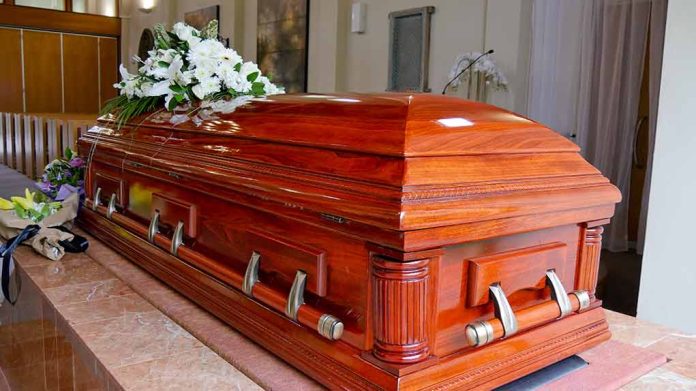
Russian families are burying sealed coffins without knowing if their loved ones are actually inside, as authorities threaten legal action against those who dare to look.
Key Takeaways
- Russian authorities are delivering sealed coffins to families of soldiers allegedly killed in Ukraine, threatening legal consequences if families attempt to verify the contents.
- Multiple documented cases show incorrect bodies being buried, with some presumed-dead soldiers later contacting their families alive, casting doubt on the entire process.
- Officials claim opening coffins violates Russian law, though no such law exists, creating a system where families cannot confirm who they’re burying.
- A study estimates up to 250,000 Russian soldiers have been killed in Ukraine since the war began, with families receiving minimal information about circumstances of death.
- The Kremlin’s official narrative of Russian involvement in Ukraine has shifted from denial to portraying soldiers as “volunteers” fighting for Russian-speaking Ukrainians.
Families Left in Agonizing Uncertainty
Throughout Russia, families of soldiers are being handed sealed coffins with strict instructions: do not open them under any circumstances. This grim reality has left countless Russians wondering if they’ve actually buried their loved ones or complete strangers. The psychological torment this creates compounds the already devastating grief of losing family members in the Ukraine conflict. Military officials deliver these coffins with minimal documentation, often just a handwritten note stating a cause of death like “blast trauma” without details on location or circumstances.
“I was hoping there was a mistake. They took so long to bring him, I thought maybe he was wounded and they were treating him,” stated Natasha.
Valeria Mikhailova’s case exemplifies this disturbing pattern. After receiving a coffin allegedly containing her husband’s remains, authorities threatened legal action if she attempted to verify its contents. When she requested photographs or permission for DNA testing, officials refused. This practice appears widespread across Russia, with families uniformly denied the basic right to confirm the identity of their deceased loved ones. The mental anguish is immeasurable as families are forced to conduct funerals with haunting uncertainty.
When the Dead Return to Life
The Kremlin’s coffin policy has resulted in truly surreal scenarios that expose the chaotic management of military casualties. In Buryatia, a family received a coffin and death certificate for a soldier named Sergei K., held his funeral, and grieved his loss—only to later receive a phone call from him, alive and hospitalized. Similar cases have emerged elsewhere in Russia, including a family in Yekaterinburg who buried a stranger’s body by mistake and were forced to hold a second funeral when they discovered the error.
“I often think, ‘Who did I bury?’ I don’t know,” said Valeria Mikhailova.
These incidents reveal a deeply flawed system of casualty management, where proper identification procedures appear to be routinely ignored. When families question the process, they face intimidation rather than answers. Valentina Mikhailova, a mother who received her son’s sealed coffin, points to glaring inconsistencies in the official account of his death. Her son’s personal belongings were never returned, and contradictory statements from military officials have left her clinging to hope that he might still be alive.
The Kremlin’s Shifting Narrative
President Putin’s handling of Russian casualties in Ukraine reveals a calculated political strategy. Initially, the Kremlin flatly denied sending troops to Ukraine at all, despite mounting evidence to the contrary. As bodies continued returning home, state media shifted to portraying the dead soldiers as patriotic “volunteers” motivated by kinship with Russian-speaking Ukrainians. This narrative transformation serves to maintain domestic support while deflecting international criticism about Russia’s direct military involvement.
“Without question, Putin is using Ukraine to achieve his domestic political goals,” said Victor Shenderovich.
The Committee of Soldiers’ Mothers estimates at least 500 Russian soldiers have been killed in Ukraine, though more recent studies suggest the true number could be as high as 250,000 since the conflict began. Despite these staggering figures, the government maintains strict control over information about military casualties. Journalists and politicians investigating these deaths have faced threats and violence, creating a climate of fear that silences grieving families and prevents them from seeking answers or accountability.
A System Designed for Deniability
The policy of sealed coffins and threatened legal action creates a perfect system of deniability for Russian authorities. Without proper identification of remains, the actual number of casualties becomes impossible to verify independently. Some families report being offered money to stay quiet, with military officials showing open contempt for their questions. One exasperated officer told a family member: “Quit calling. They’ll give you 100,000 rubles ($1,850) — more than enough to drink and remember him. What more do you want?”
“Everyone around has lied about it. The military enlistment office told us that his body… was identified by his fellow soldiers and his commander, and that there was no need for a DNA test. Then, it turned out that his fellow soldiers had lost him altogether and there was no identification at all,” said Valentina Mikhailova.
Kyiv has accused Moscow of sending mutilated bodies and mixing body parts, further complicating identification efforts. For Russian families, the situation creates an agonizing limbo—unable to confirm deaths, yet forced to conduct funerals without certainty. Some, like the Mikhailov family, are pursuing legal avenues to obtain court orders for DNA testing, but they face an uphill battle against a system deliberately designed to obscure the human cost of Putin’s military actions in Ukraine.













